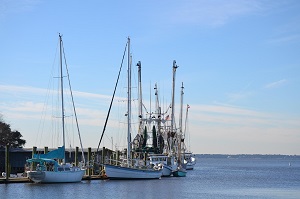![]() Overfishing and Aquatic Resource Depletion is a news and information topic monitored and covered by: Prepper Watch – Food Concerns
Overfishing and Aquatic Resource Depletion is a news and information topic monitored and covered by: Prepper Watch – Food Concerns
Introduction
Overfishing and aquatic resource depletion are urgent global issues that threaten the health of oceans, ecosystems, and communities dependent on seafood. As the demand for marine resources continues to rise and the fish stocks dwindle, the need for sustainable practices and effective preparedness becomes more crucial than ever.
For preppers, preparing for overfishing and aquatic resource depletion is not just about ensuring they have a secure food supply; it’s about safeguarding resources, developing alternative strategies for food and water sourcing, and securing a self-sufficient lifestyle in the face of potential crises.
In this blog, we will explore practical strategies preppers can implement to prepare for overfishing and aquatic resource depletion, ranging from sustainable fishing practices to alternative food sources, water management, and long-term survival solutions. The goal is to equip individuals with the knowledge and tools needed to mitigate the effects of this environmental crisis on their preparedness plans.
Understanding Overfishing and Aquatic Resource Depletion
Before diving into the specific preparedness strategies, it’s essential to understand what overfishing and aquatic resource depletion entail. Overfishing occurs when fish and other marine species are harvested at rates faster than they can naturally reproduce, leading to a reduction in population sizes. This not only threatens the biodiversity of marine ecosystems but also destabilizes seafood supplies, affecting food security for billions of people worldwide.
Aquatic resource depletion refers to the depletion of various aquatic resources, including fish, shellfish, and other marine life, as well as the broader ecological damage caused by overfishing, such as coral reef destruction and the loss of habitat for marine species. When marine resources are exhausted, they can take decades or even centuries to recover, depending on the severity of the damage.
Given that seafood is a primary protein source for many, this depletion of aquatic resources could lead to significant disruptions in global food chains. Preppers must be ready to adapt to these changes by diversifying their food sources, securing alternative freshwater supplies, and developing strategies to maintain their independence.
Building a Sustainable Food Supply
For preppers, the first line of defense against overfishing and aquatic resource depletion is ensuring a sustainable food supply. This involves minimizing dependence on depleting marine resources and focusing on alternative sources of food.
Growing Your Own Food
While overfishing affects aquatic life, it doesn’t directly impact terrestrial food production. Preppers should focus on creating self-sustaining gardens that can provide them with fresh produce. This can include fruits, vegetables, herbs, and even small livestock like chickens or goats. By growing your own food, you reduce your reliance on external food sources, many of which could be affected by overfishing and other environmental crises.
- Crop Diversity: Grow a variety of crops to ensure a balanced diet. Consider crops that are nutrient-dense, such as leafy greens, beans, and root vegetables.
- Seasonal Planting: Plan for year-round production by using greenhouse space or cold frames in colder climates.
- Aquaponics: This hybrid system combines aquaculture (raising fish) and hydroponics (growing plants in water). It offers a sustainable way to produce both fish and vegetables while conserving water and minimizing reliance on traditional fishing.
Preserving Fish Stocks
For preppers who continue to rely on aquatic resources, adopting sustainable fishing practices is vital. This includes being mindful of fishing quotas, using non-destructive fishing methods, and considering aquaculture (fish farming) to help alleviate pressure on wild fish populations.
- Catch Limits: Research and respect local and global catch limits to avoid contributing to the depletion of marine resources.
- Selective Harvesting: Use fishing methods that target specific species and sizes to prevent over-harvesting of juvenile or endangered fish.
- Aquaculture: Setting up small-scale aquaculture systems for raising fish can provide a reliable, sustainable source of protein. Consider species like tilapia, catfish, or trout that are easier to farm and manage.
Diversifying Food Sources
In the face of overfishing, it’s essential to diversify your food sources to avoid relying too heavily on marine resources. Here are some effective ways to ensure a diverse food supply:
Plant-Based Alternatives
While many preppers focus on meat and animal protein, plant-based protein sources like beans, lentils, quinoa, and tofu can significantly reduce dependence on fish and animal farming. These sources of protein are often more environmentally sustainable than animal farming and can be easily incorporated into your long-term food storage plans.
- Plant Protein: Stock up on dried beans, lentils, soy products, and other plant-based protein sources. These are shelf-stable and easy to store.
- Herb Gardens: Incorporate a variety of herbs into your garden to boost flavor and nutritional value. Many herbs also have medicinal uses, which can be beneficial in times of scarcity.
Wild Foraging
In addition to growing your own food, foraging can provide wild, nutritious foods that are often overlooked. Preppers should learn the basics of wild foraging in their region, especially when it comes to edible plants, fungi, and small game.
- Mushrooms: Many wild mushrooms are an excellent source of protein and vitamins.
- Wild Berries and Greens: Many edible wild plants, such as dandelion greens, clover, and wild berries, can supplement your diet.
Livestock and Poultry
Raising animals like chickens, goats, or even rabbits can offer a reliable source of protein, reducing the need for fish. Small livestock are easier to manage than large-scale farming and can be raised in confined spaces, making them ideal for urban or suburban preppers.
- Eggs and Milk: Chickens provide eggs, while goats can be milked for dairy products. Both are valuable, renewable sources of nutrition.
- Meat Production: Rabbits, goats, and poultry can provide meat, which is an essential part of a balanced prepper diet.
Water Conservation and Management
The depletion of aquatic resources affects not only fish but also freshwater sources. With overfishing and aquatic resource depletion, the ecosystem is further strained, and access to clean water could become limited. Preppers must consider water conservation and management to safeguard against potential water shortages.
Rainwater Harvesting
Setting up a rainwater harvesting system allows preppers to capture and store water for future use, reducing dependence on external water sources. This water can be used for irrigation, livestock, and even filtration for drinking.
- Water Filtration: Implement filtration systems to ensure water is safe to consume.
- Storage Tanks: Install large storage tanks to accumulate rainwater, especially in areas prone to drought.
Aquatic Plant Cultivation
Aquatic plants, such as algae or watercress, can be cultivated in a sustainable manner and provide food as well as contribute to water filtration. These plants often thrive in aquaponic systems or can be grown in shallow ponds.
- Algae Farming: Algae can be used for food, biofuel production, and water purification.
- Watercress: This aquatic plant grows in cool, moving water and is highly nutritious.
Alternative Proteins and Food Preservation
As the depletion of marine life becomes more widespread, preppers should seek out alternative protein sources, especially those that can be stored for long periods.
Insect Farming
Insects are a highly sustainable and nutritious protein source. Farming insects such as crickets, mealworms, and locusts provides a food source that is environmentally friendly and can be done on a small scale.
- Nutritional Benefits: Insects are rich in protein, healthy fats, and vitamins.
- Ease of Farming: Insects require little space and can be farmed indoors or outdoors in controlled environments.
Freeze-Dried Foods
Freeze-dried foods are an excellent way to store long-term food supplies without relying on traditional seafood. These foods retain their nutritional value and shelf life for many years.
- Prepared Meals: Freeze-dried meals like soups, stews, and meat-based dishes are easy to store and prepare in emergencies.
- Freeze-Dried Fish: While this still involves fish, freeze-dried fish can be stored for longer periods and may become a more sustainable option.
Building a Community Network
In times of resource depletion, community support becomes more important than ever. Building a community of like-minded individuals can help ensure that resources are shared, knowledge is passed along, and survival is made more feasible.
Mutual Assistance Groups (MAGs)
Forming a MAG can provide a network of support when resources are scarce. MAGs are groups of people who share knowledge, skills, and resources to ensure the survival of the group.
- Skill Sharing: Members can contribute their expertise in various areas, such as farming, fishing, first aid, and water purification.
- Resource Sharing: By pooling resources, groups can better manage their food and water supplies.
Conclusion
Overfishing and aquatic resource depletion are pressing issues that demand proactive responses from preppers. By diversifying food sources, adopting sustainable fishing practices, conserving water, and building community support networks, preppers can create a self-sufficient lifestyle that minimizes reliance on dwindling marine resources.
Preparedness is not just about surviving; it’s about thriving in a world where the future of aquatic life is uncertain. By taking these steps, preppers can mitigate the impacts of overfishing and aquatic resource depletion, ensuring their long-term survival and resilience.

